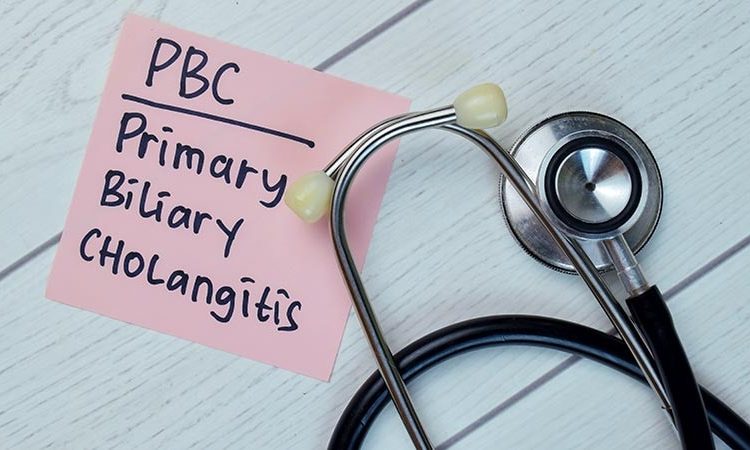BOSTON — Seladelpar, a first-in-class investigational agent that targets multiple cell types and processes in primary biliary cholangitis (PBC), was significantly better than placebo at reducing key prognostic markers for disease activity and moderate to severe itching in the RESPONSE phase 3 trial.
After 12 months of treatment, close to 62% of adult patients who received seladelpar met the primary composite biochemical endpoint of a significant decrease in alkaline phosphatase (ALP) levels and/or normalization of total bilirubin levels, compared to 20% who received placebo, reported Gideon Hirschfeld, FRCP, PhD, from the Toronto Center for Liver Disease at Toronto General Hospital in Toronto, Ontario, Canada.
“Approximately 1 in 4 patients met the key secondary endpoint of ALP normalization,” he added, “and the mean reduction in ALP was 42%, or a drop of 133.9 units per liter.”
Patients randomly assigned to the seladelpar arm also showed significant improvement of pruritus and reductions in liver transaminase levels, triglyceride levels, and LDL cholesterol levels, said Hirschfeld in a late-breaking abstract session here at The Liver Meeting 2023: American Association for the Study of Liver Diseases (AASLD).
PBC, a chronic, progressive autoimmune disease, affects approximately 1 in 1000 women over 40. Symptoms often include moderate to severe pruritus and fatigue. The hallmark of the disease is cholestasis, the accumulation of bile acids, progression to inflammation, and subsequent degradation of intrahepatic bile ducts.
Seladelpar is a selective agonist of peroxisome proliferator-activated receptor delta (PPARδ), abbreviated as delpar, a lipid-activated transcription factor.
According to the investigational drug’s manufacturer, CymaBay Therapeutics, seladelpar has been shown “to regulate genes involved in bile acid synthesis, inflammation, fibrosis and lipid metabolism, storage, and transport.”
RESPONSE Details
Hirschfeld and colleagues in North America, South America, Europe, Asia, and Australia enrolled 193 patients with PBC for whom the standard of care, ursodeoxycholic acid (UDCA), produced an inadequate response or who were intolerant of UDCA.
Eligible patients had ALP levels of at least 1.67 times the upper limit of normal (ULN), alanine aminostransferase (ALT) and aspartate aminotransferase (AST) levels three times ULN or lower, and total bilirubin levels two times ULN or lower. Patients with compensated cirrhosis were allowed to enroll.
After stratification by ALP and pruritus levels, the patients were randomly allocated on a 2:1 basis to receive seladelpar 10 mg orally daily or placebo for 1 year. At the end of the treatment period, patients had the option of continuing on an open-label long-term study. Those who did not continue had a 2-week safety follow-up visit.
Of patients taking seladelpar, 61.7% (79 of 128) met the primary composite endpoint of either ALP less than 1.67 times ULN, a 15% or greater decrease in ALP, and/or total bilirubin at or below ULN. In contrast, 20% of patients assigned to placebo (13 of 65) met the primary endpoint (P < .0001).
The mean ALP change from baseline was -42.4% in the seladelpar arm, compared with -4.3% in the placebo arm.
In all, 25% of patients treated with seladelpar experienced normalization of ALP, compared with 0% of patients who received placebo (P < .0001).
Use of the delpar agonist was also associated with significantly greater reductions in serum markers of liver injury and lipids, including ALT, LDL cholesterol, gamma-glutamyl transferase, and triglycerides.
In addition, use of seladelpar was associated with significantly greater reductions in itching among patients with a baseline Peak Pruritus Numerical Rating Scale score of 4 or greater. It was also associated with a significant reduction in levels of the pruritogenic cytokine interleukin-31 at months 3 and 6.
The reduction in itching was associated with a lessening of sleep disturbances both in patients with moderate to severe itching and in the overall patient population, Hirschfeld said.
Treatment-related adverse events occurred in 17.2% of patients taking seladelpar and in 12.3% of patients taking placebo. There were no treatment-related adverse events of grade 3 or greater, and there were no treatment-related serious adverse events. Liver-related adverse events occurred in 6.3% of patients taking the active drug, vs 9.2% of patients taking placebo.
Fibrosis Effects Still Unknown
This was a “great, impressive study,” said Aleksander Krag, MD, PhD, from the University of Southern Denmark and head of hepatology at Odense (Denmark) University Hospital, who was co-moderator of the session.
“I think you very convincingly demonstrated that it reduced markers of disease activity,” he told Hirschfeld.
He asked whether the investigators had assessed direct markers of liver fibrosis and whether they had changed over the course of the study.
Hirschfeld said that both FibroScan and Enhanced Liver Fibrosis data are currently being analyzed and will be presented at a future date.
“However, I would say that even a 12-month study is relatively short to necessarily see a significant change, particularly in FibroScan, in an already treated group of patients with PBC who have had disease for quite a significant time,” he continued, adding that answers about the effect of seladelpar on fibrosis would be likely to come from the long-term follow-up study, which includes a majority of patients enrolled in the RESPONSE study.
The study was sponsored by CymaBay Therapeutics. Hirschfeld disclosed consulting for CymaBay and others and participating in lectures, presentations, speeches, and writing and educational events for GlaxoSmithKline, Intercept, and Ipsen. Krag disclosed receiving speaker fees from Novo Nordisk, Norgine, Siemens, and Nordic Bioscience and participating in advisory boards for Norgine, Siemens, Resalis Therapeutics, Boehringer Ingelheim, and Novo Nordisk. He has received research support from these companies and others.
Neil Osterweil, an award-winning medical journalist, is a long-standing and frequent contributor to Medscape.
Source: Read Full Article
